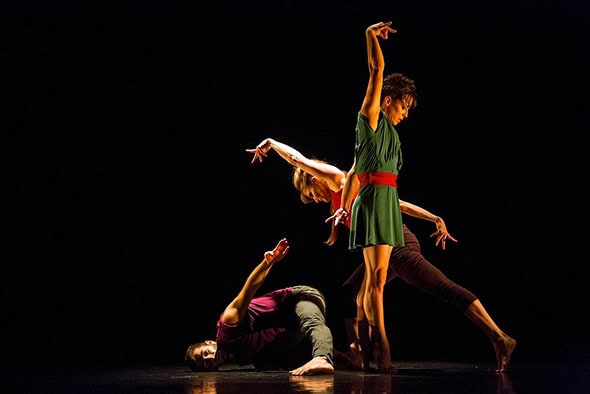Kamala Devam Company: Ankusha and Other Mysteries at Bernie Grant Arts Centre
Posted: December 12th, 2018 | Author: Nicholas Minns | Filed under: Performance | Tags: Ankusha and Other Mysteries, Danny Keane, Kamala Devam, Kamila Lewandowska, Martina Trottman, Pirashanna Thevarajah, Seeta Patel, Swati Seshadri, Tamzen Moulding | Comments Off on Kamala Devam Company: Ankusha and Other Mysteries at Bernie Grant Arts CentreKamala Devam Company, Ankusha and Other Mysteries, Bernie Grant Arts Centre, December 1

Kamala Devam has a lot going for her and she is making the most of it. Ankusha and Other Mysteries, presented at Bernie Grant Arts Centre, is an ambitious program of five works, four of which she has choreographed on herself or on her company, and the fifth is the 2013 film, The Art of Defining Me, which confounds the political box-ticking of cultural assimilation in which she is inevitably caught up. As she quips in the film, she’s the ‘white pinup girl for Indian dance in England’. As a child of California Hippies she began learning bharatanatyam at the age of five and has reached a level where she can command the stage in a classical solo. She also studied western contemporary dance so inevitably her style blurs the edges of both techniques; this is what makes her fascinating to watch. The energy and motivation of a contemporary arm movement will suddenly make an appearance in the course of a bharatanatyam solo, and in contemporary work her clarity of gesture derives from her classical training.
The opening work of Ankusha and Other Mysteriesis a case in point. Less of Meis a solo Devam created in 2014 in which she ‘reflects on the space she has inside her’ following surgery to remove a cyst. Sitting on the floor facing away from us, she seems to tell the story through her expressive back while using text to provide her thought processes. It’s a gem of a work that explores her disbelief in losing an internal growth only to find the body is still miraculously fully functional without it. It is reminiscent of Laura Dannequin’s Hardy Animal; both works are concerned with deepening the psychological and somatic understanding of the body as an expressive medium while using the body as the means of investigation.
Seeing the short film, The Art Of Defining Me, directed by Devam and Seeta Patel, in the interval between Less of Meand Devam’s bharatanatyam solo, Jati-Swara-Leela, is to watch the very fluid question of identity first in satirical theory and then in practice. It says a lot about the pioneering work of Patel and Devam that five years after the film’s launch its influence can be felt in the programing of such works as Patel’s Not Today’s Yesterdayand Devam’s Ankusha and Other Mysteries.
In the great Indian tradition of the intimate, often improvised connection between dancer and accompaniment, Jati-Swara-Leelais graced with three accomplished musicians on stage playing a composition by Prathap Ramachandra: Danny Keane on cello, the versatile Pirashanna Thevarajah on percussion and Swati Seshadri as nattuvana. Choreographing on herself and costumed by Martina Trottman, Devam naturally inhabits the traditional style and at the same time suffuses it with contemporary sensibility; for all her refinement of bharatanatyam gesture and pose, she employs a spatial awareness and attack that redefines the form in her own image.
The title of the next work, Babushka vs. Renaissance Man, points to another amalgam of cultural identity but despite the geographical allusions Devam describes it as ‘a choreographic investigation into the meeting points between the movement cultures of popping and kalaripayattu, a South Indian martial art’. The solo, set on popper Kamila Lewandowska, extends Devam’s choreographic evolution by negotiating a dialogue between two separate dance forms on a body that is not her own but it’s a more artificial composite than Jati-Swari-Leela where her intrinsic ability to channel two forms is entirely organic. It also raises the question of what you do once the two dance forms have met; Devam has made the introduction and Lewandowska’s body engages in the conversation but the choreographic form of Babushka vs. Renaissance Man remains too self-consciously contained to fully develop the relationship.
The final work, Ankusha, moves in another direction in which Devam develops the action through three performers: herself, Tamzen Moulding and Franco Conquista. An ankusha is an elephant goad but Devam suggests it’s symbolic connotation as the Hindu god Lord Ganesha directing souls toward their destiny and keeping them on track. Ankusha keeps the vast theme of fate intimate in the way the paths of the three performers wrap tightly around and over each other, but while the philosophical idea is clear the acrobatic authority of Moulding and Conquista, who are both circus performers, too easily governs the narrative elements. Nevertheless Devam is clearly taking the lessons of Ankusha to push — and pull — the boundaries of her work in a direction that arises from her own unique identity.